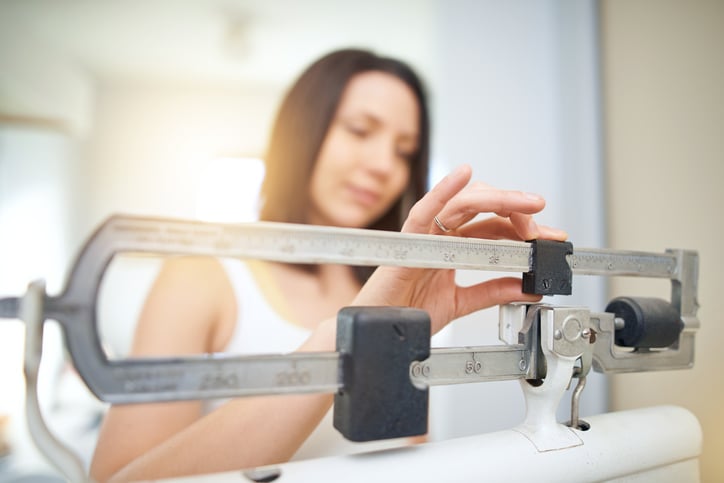Ask the Coaches: How Do I Figure Out My Ideal Body Weight?

Q: Hey Coach, how do you know when you’ve reached a “good” weight to maintain? In other words, how do you figure out what your ideal body weight is?
I’m 5’7” and would like to be close to 130 pounds, but I don’t know if that’s a healthy weight for me or not. I’ve been at 122 pounds—before children—but I was not maintaining it in a healthy way. Is 130 pounds a healthy goal weight? I’m assuming I should use the BMI as a guide?
-Carissa
A: This question about how to figure out what your ideal body weight is is a great one, Carissa. Thanks for sharing! Actually, it’s one we hear quite often. In fact, BioTrust Chief Scientific Officer and Registered Dietitian Shawn Wells and I covered this very topic on one of our recent podcasts, which you can listen to here.
I’m glad you mentioned BMI, which stands for Body Mass Index, as that’s a great place to start the discussion on ideal body weight. Simply put, BMI is a ratio of your weight relative to your height, and it is calculated by dividing your weight (in kilograms) by your height (in meters2). If you’re interested, you can determine your BMI by using this handy calculator from the National Institutes of Health.
BMI is supposed to be an estimate of body fatness, with the following ranges established:
- Underweight: < 18.5
- Normal weight: 18.5 – 24.9
- Overweight: 25 – 29.9
- Obese: ≥ 30
The assumption is that a higher BMI implies greater health risks, and while there are benefits to this tool (such as ease of use and its application on a population-wide basis), the truth is that there are significant limitations with BMI. Here are some of the major issues:
- BMI doesn’t consider factors such as age, sex, or ethnicity, which may influence the relationship between BMI and body fat. For instance, at an identical BMI, older adults tend to have more body fat than younger adults. In other words, an older person might be “normal weight” but have concerningly low levels of muscle mass. Speaking of which…
- BMI doesn’t distinguish between fat and fat-free mass, such as muscle and bone. In other words, BMI doesn’t tell us about your quality of weight or percentage of body fat. For example, folks with above-average amounts of muscle could be considered “overweight” or even “obese” by BMI standards when, in fact, they are perfectly healthy and at an “ideal” body weight for them. For what it’s worth, my BMI puts me in the “overweight” category, and while I know there’s always room for improvement, I feel like I’m in good shape and at a “healthy” weight.
- BMI doesn’t tell us about how you store fat or your body fat distribution. This is tremendously important, and it’s something I’ve elaborated on when discussing the best measurements to track for health.
As I alluded to there, excess abdominal fat is downright risky when it comes to health. Along those lines, it’s completely possible to be “normal weight” (by BMI standards) yet have dangerous levels of abdominal fat, which significantly increases one’s risk of mortality. On the flipside, overweight and grade 1 obesity (BMI < 35) are not associated with increased mortality. In fact, being overweight is associated with lower all-cause mortality.
In other words, there’s evidence suggesting that being “overweight” (like me, for instance) may be healthier than being “normal” weight. Crazy, right?
This is known as the “obesity paradox,” which refers to better health outcomes in overweight and obese folks (compared to “normal weight” people). Another term that’s commonly mentioned is overweight (or obese) but “metabolically healthy,” or “fat and fit.” This refers to folks who are overweight or obese (by BMI standards) yet have healthy blood sugar levels, blood pressure, triglycerides, and cholesterol levels.
Focus on Quality, Not Quantity
This brings us to an important distinction between weight loss and quality weight loss, which focuses on reducing excess body fat (especially abdominal fat) while maintaining (or better yet, increasing) calorie-burning lean muscle, which has functional (e.g., strength, balance) and metabolic (e.g., glycemic control, metabolic rate) importance. In other words, the emphasis is on improving body composition, such as reducing body fat percentage.
There are quite a few ways to assess body fat percentage. On one hand, it’s nice to have options, which increase accessibility and ease of use. But that comes at a cost because different methods (with varying degrees of reliability and validity) yield different results. And that makes it problematic to identify “healthy” targets like ideal body weight.
Having said that, there are standard body fat percentage thresholds, or “cut-points,” for obesity, and they are typically set at:
- 25% for men
- 35% for women
In other words, a healthy weight—or ideal body weight, if you will—would be a body fat percentage below these cut-points. Keep in mind that these are “ceilings,” and body fat levels below these are certainly healthy (up to a point, of course). However, this provides at least some minimum criteria, although the following ranges may be closer to “ideal”:
- 11 – 24% for men
- 16 – 34% for women
Because of the margin for error in body composition testing and the inaccessibility (for some people), there are a few other measurements that are less weight-conscious and scale-centric that definitely bear mentioning. Specifically, waist circumference, waist-to-hip ratio, and waist-to-height ratios are very good indicators of abdominal obesity and, therefore, health. Here are some guidelines for each:
- Waist circumference:
- Men: < 94 cm or <37 in
- Women: < 80 cm or <31.5 in
- Waist-to-hip ratio:
- Men: < 0.90
- Women: < 0.85
- Waist-to-height ratio:
- Men: < 0.53
- Women: < 0.54
What Is YOUR Ideal Body Weight?
I know we humans love things in black and white, and I’m sorry it’s not that simple. And just like I talked about in the best measurements to track health article, there are other factors to consider beyond weight, such as levels of physical activity, fitness, and strength, as well as certain biomarkers (e.g., blood sugar).
In other words, lifestyle factors play a tremendous role in overall health, and as Peter Janiszewski (Ph.D. in obesity research) says, “I would argue this is the biggest drawback of using BMI: it doesn’t always change even though you may be getting healthier. This is particularly so if you adopt a physically active lifestyle along with a balanced diet but are not necessarily cutting a whole lot of calories. This lack of change in BMI, or body weight, is all too often interpreted as failure, resulting in the disappointed individual resuming their inactive lifestyle and unhealthy eating patterns.”
Along those lines, I’d completely agree with Dr. Janiszewski, who says, “On an individual basis, the greater focus should be on healthy behaviors: physical activity and a healthy diet.” To that, I would consider taking a page from the Ayurveda holistic system of healthcare, which emphasizes the union of mind, body, and spirit. In other words, additional lifestyle factors to address include restorative sleep, stress management (e.g., meditation), healthy relationships (e.g., positive social support), and healthy emotions.
There’s one final, albeit critical piece to figuring out your ideal body weight, and that is sustainability, which directly counters the typical short-term mindset and “all-in” approach that most adopt when it comes to weight loss.
This is why I really like a concept I was introduced to by Dr. Traci Mann in her book Secrets from the Eating Lab. Instead of aiming for some arbitrary number, Dr. Mann suggests that people strive for their leanest livable weight, which she describes as “a weight you can maintain while having a normal life. If it’s a weight you cannot maintain, that is not your leanest livable weight.”
I would simply tack onto that…while doing the best you can to consistently practice an overall healthy lifestyle (and hitting your ideal body weight).







